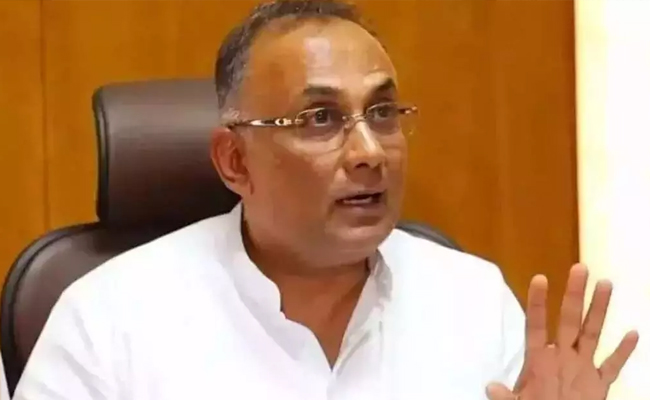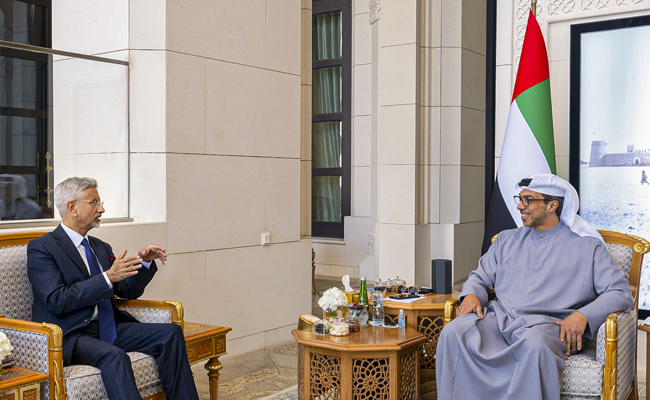New Delhi: Ahead of the Delhi Assembly elections, a war of words has unfolded between the Bharatiya Janata Party (BJP) and the Aam Aadmi Party (AAP) over allegations of extravagance at the chief minister’s residence. While BJP leaders criticised former Delhi CM Arvind Kejriwal for constructing a lavish ‘Sheesh Mahal’ for himself, the AAP hits back, accusing prime minister Narendra Modi of residing in a ‘Rajmahal’ worth Rs 2,700 crores.
In this context, an image of PM Modi seemingly wearing an expensive watch in a room showcasing wall-to-wall expensive objects has gone viral.
An X user shared the image and wrote, “This photo was secretly sent by an employee working at the PM’s residence but sends his children to the schools built by Arvind Kejriwal. He secretly clicked this picture today at 3 pm while the PM was wearing this costly watch. He revealed that in this ‘Rajmahal’, there are separate rooms dedicated to expensive luxury items such as fancy suits, shoes, glasses, pens and other indulgent items. With Rs 2,700 crores spent, what isn’t possible, brother?” (Translated from Hindi) (Archive)
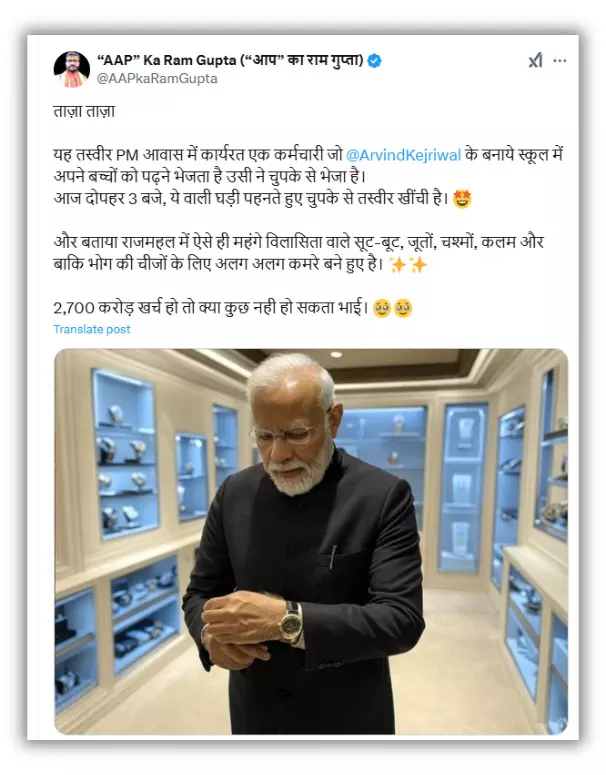
Fact Check
Claim: The leaked image shows prime minister Narendra Modi wearing an expensive watch in one of the luxurious rooms at his residence.
Fact: The claim is false. The image is AI-generated.
NewsMeter found that the claim is false. The ‘leaked photo from PM’s residence’ is an AI-generated image.
Upon close examination of the image, we identified a watermark for ‘Grok AI’. Grok Image Generator is a generative AI tool designed to create art and visuals from text inputs. Its official website states that it is specifically built for artistic creations.
Further scrutiny of the image revealed several inconsistencies, common among AI-generated images.
Some of the obvious discrepancies include the frame of the prime minister’s spectacles appearing incomplete and fingers showing visible distortion. Additionally, the overly glossy texture of the image and the blurred background are signs of AI-generated media.
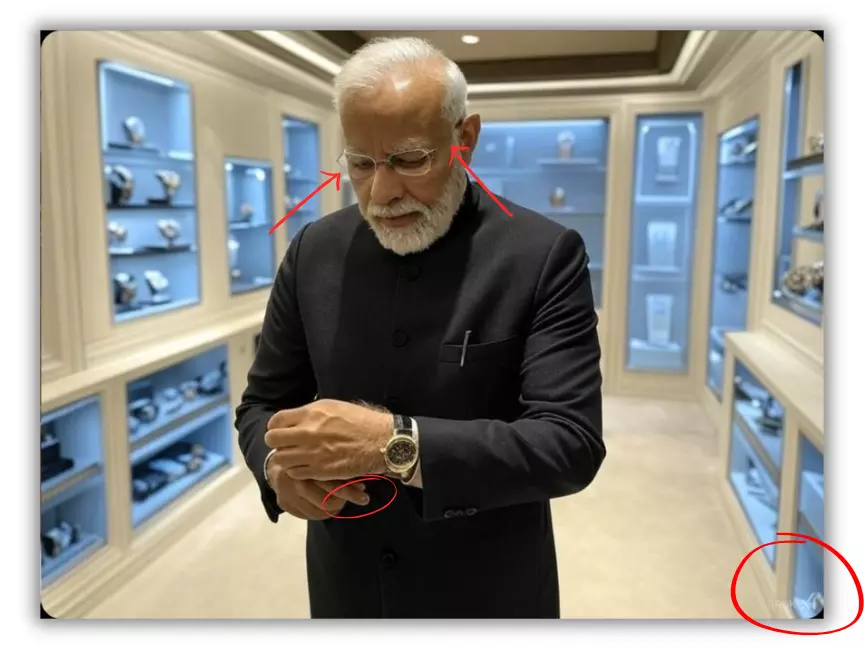
Next, we ran the image through AI detection tools to decide its authenticity.
Hive Moderation identified the image as AI-generated with an aggregate confidence score of 98.4 per cent. Wasitai confirmed that the image, or a substantial portion of it, was created by AI. Another tool, AI Image Detector, analysed the image and determined it to be 53.26 per cent AI-generated and 45.18 per cent human-generated.

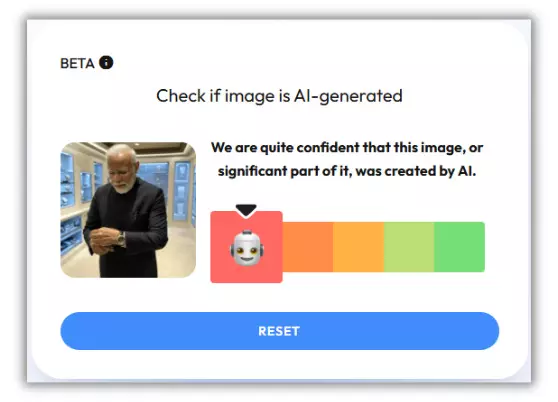
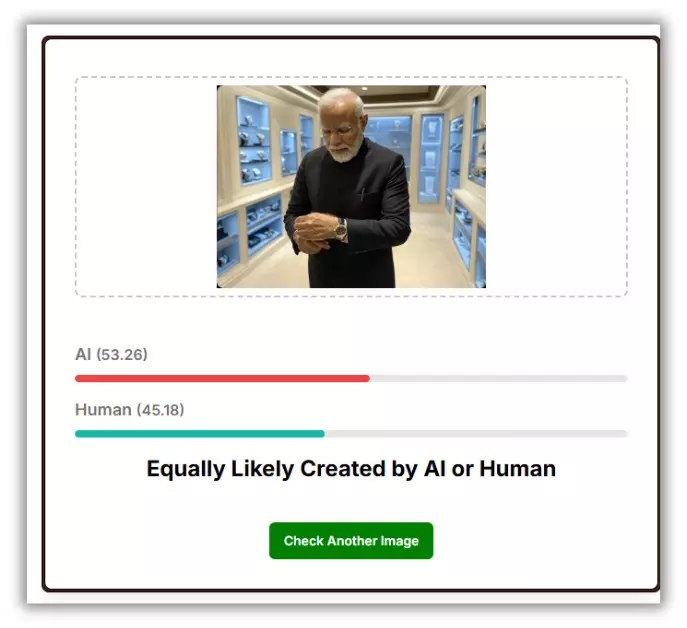
Therefore, we conclude that the viral image was fabricated using AI.
(This story was originally published by News Meter, and republished by english.varthabharti.in as part of the Shakti Collective)
Let the Truth be known. If you read VB and like VB, please be a VB Supporter and Help us deliver the Truth to one and all.
New Delhi: A bill to set up a 13-member body to regulate institutions of higher education was introduced in the Lok Sabha on Monday.
Union Education Minister Dharmendra Pradhan introduced the Viksit Bharat Shiksha Adhishthan Bill, which seeks to establish an overarching higher education commission along with three councils for regulation, accreditation, and ensuring academic standards for universities and higher education institutions in India.
Meanwhile, the move drew strong opposition, with members warning that it could weaken institutional autonomy and result in excessive centralisation of higher education in India.
The Viksit Bharat Shiksha Adhishthan Bill, 2025, earlier known as the Higher Education Council of India (HECI) Bill, has been introduced in line with the National Education Policy (NEP) 2020.
The proposed legislation seeks to merge three existing regulatory bodies, the University Grants Commission (UGC), the All India Council for Technical Education (AICTE), and the National Council for Teacher Education (NCTE), into a single unified body called the Viksit Bharat Shiksha Adhishthan.
At present, the UGC regulates non-technical higher education institutions, the AICTE oversees technical education, and the NCTE governs teacher education in India.
Under the proposed framework, the new commission will function through three separate councils responsible for regulation, accreditation, and the maintenance of academic standards across universities and higher education institutions in the country.
According to the Bill, the present challenges faced by higher educational institutions due to the multiplicity of regulators having non-harmonised regulatory approval protocols will be done away with.
The higher education commission, which will be headed by a chairperson appointed by the President of India, will cover all central universities and colleges under it, institutes of national importance functioning under the administrative purview of the Ministry of Education, including IITs, NITs, IISc, IISERs, IIMs, and IIITs.
At present, IITs and IIMs are not regulated by the University Grants Commission (UGC).
Government to refer bill to JPC; Oppn slams it
The government has expressed its willingness to refer it to a joint committee after several members of the Lok Sabha expressed strong opposition to the Bill, stating that they were not given time to study its provisions.
Responding to the opposition, Parliamentary Affairs Minister Kiren Rijiju said the government intends to refer the Bill to a Joint Parliamentary Committee (JPC) for detailed examination.
Congress Lok Sabha MP Manish Tewari warned that the Bill could result in “excessive centralisation” of higher education. He argued that the proposed law violates the constitutional division of legislative powers between the Union and the states.
According to him, the Bill goes beyond setting academic standards and intrudes into areas such as administration, affiliation, and the establishment and closure of university campuses. These matters, he said, fall under Entry 25 of the Concurrent List and Entry 32 of the State List, which cover the incorporation and regulation of state universities.
Tewari further stated that the Bill suffers from “excessive delegation of legislative power” to the proposed commission. He pointed out that crucial aspects such as accreditation frameworks, degree-granting powers, penalties, institutional autonomy, and even the supersession of institutions are left to be decided through rules, regulations, and executive directions. He argued that this amounts to a violation of established constitutional principles governing delegated legislation.
Under the Bill, the regulatory council will have the power to impose heavy penalties on higher education institutions for violating provisions of the Act or related rules. Penalties range from ₹10 lakh to ₹75 lakh for repeated violations, while establishing an institution without approval from the commission or the state government could attract a fine of up to ₹2 crore.
Concerns were also raised by members from southern states over the Hindi nomenclature of the Bill. N.K. Premachandran, an MP from the Revolutionary Socialist Party representing Kollam in Kerala, said even the name of the Bill was difficult to pronounce.
He pointed out that under Article 348 of the Constitution, the text of any Bill introduced in Parliament must be in English unless Parliament decides otherwise.
DMK MP T.M. Selvaganapathy also criticised the government for naming laws and schemes only in Hindi. He said the Constitution clearly mandates that the nomenclature of a Bill should be in English so that citizens across the country can understand its intent.
Congress MP S. Jothimani from Tamil Nadu’s Karur constituency described the Bill as another attempt to impose Hindi and termed it “an attack on federalism.”

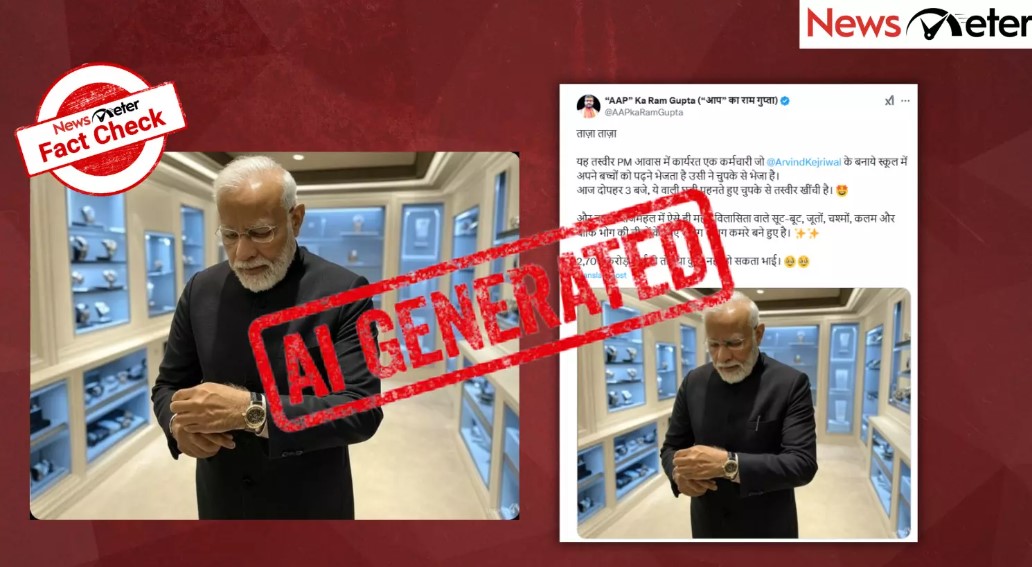
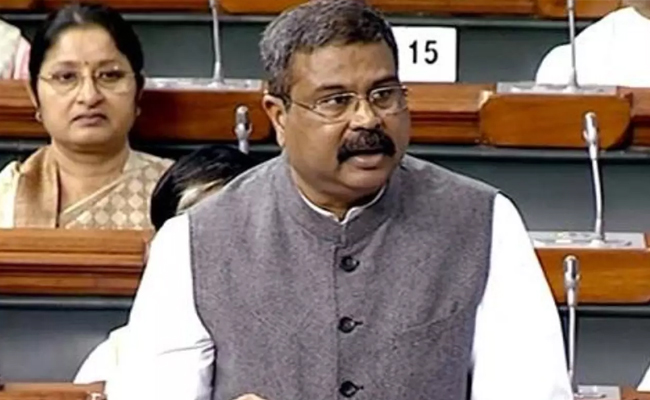
_vb_22.jpeg)
